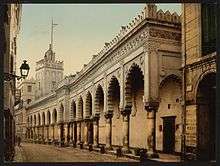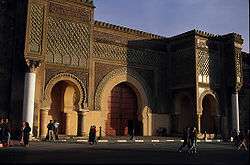Moorish architecture
Moorish architecture is the architectural tradition that appeared in the Maghreb region and the Iberian peninsula during the Islamic period.
Architecture
Characteristic elements of Moorish architecture include muqarnas, horseshoe arches, voussoirs, domes, crenellated arches, lancet arches, ogee arches, courtyards, and decorative tile work. The architectural tradition is exemplified by great buildings such as the Mezquita in Córdoba (784–987, in four phases); the Alhambra (mainly 1338–1390[1]) and Generalife (1302–9 and 1313–24) in Granada and the Giralda in Seville in 1184;[2] Paderne Castle in the Algarve, Portugal; the mosque of Koutoubia and University of Al-Karaouine in Morocco; the Great Mosque of Algiers and the Great Mosque of Tlemcen in Algeria; and the Mosque of Uqba in Kairouan, Tunisia. Other notable buildings include the ruined palace city of Medina Azahara (936-1010), the church (former mosque) San Cristo de la Luz in Toledo, the Aljafería in Zaragoza and baths at for example Ronda and Alhama de Granada.
The term is sometimes used to include the products of the Islamic civilisation of Southern Italy.[3] The Palazzo dei Normanni in Sicily was begun in the 9th century by the Emir of Palermo.
There is archeological evidence of an eighth-century mosque in Narbonne, France.[4]
By country
Spain
- Alicante
- Antequera
- Almería
- Badajoz
- Bailén
- Baños de la Encina Castle (Burgalimar)
- Córdoba
- Gormaz
- Granada
- Alhambra and Generalife
- Cuarto Real de Santo Domingo
- Albayzín
- Jaén
- Jerez de la Frontera
- Málaga
- Mérida
- Seville
- Toledo
- Trujillo
- Alcazaba
- Zaragoza
Major monuments
Caliphate of Córdoba (929-1031):
- Medina Azahara (936-1010) in Córdoba
- Mosque of Cristo de la Luz in Toledo (completed 999/1000)
- "Minaret of San Juan" (930) at Córdoba, once belonging to a mosque
- Archaeological site of the Villarrubia palace (965-66)
Period of Taifas (11th-13th century):
- the Mezquita de las Tornerías in Toledo (ca. 1060)
- the Almohad minaret known as Giralda (1184–98) at Sevilla, once part of the Great Mosque of Sevilla (1172–1176)
- Aljaferia palace (second half of the 11th century) of the Banu Hud dynasty (1039–1110) in Zaragoza;
- minaret at the Church of San José at Granada (ca. 1050)
- Almohad Minaret at Iglesia de San Juan de los Reyes at Granada
Nasrid Emirate of Granada (1212–1492):
- the Alhambra (mainly 1338-1390) and the Generalife (1302-24 in two phases), a country palace initially linked to the Alhambra by a covered walkway across the ravine that now divides them.
- Granada Hospital (Maristan) (1365-7)
- Masjid of the madrasa of Yusuf I (1349) in the so-called Palacio de la Madraza
- New Funduq of Granada (14th century)
- Qaysariyya of Granada (15th century)
Portugal

India
Algeria, Morocco & Tunisia
There is a high concentration of Moorish architecture in the Maghrebi states of Algeria, Morocco and Tunisia mainly in the cities of Tlemcen, Algiers, Marrakech, Tunis, and Testour.
See also
- Berber architecture
- Arab-Norman culture
- Islamic influences on Christian art
- Moorish Revival*
- Moroccan architecture
- Mudéjar
- Mudéjar Architecture of Aragon
Notes
References
- Curl, James Stevens (2006). A Dictionary of Architecture and Landscape Architecture (Paperback) (Second ed.). Oxford University Press. p. 880 pages. ISBN 0-19-860678-8.
- Barrucand, Marianne; Bednorz, Achim (2002). Moorish Architecture in Andalusia. Taschen. p. 240 pages. ISBN 3-8228-2116-0.
Gallery
| Berber Buildings | ||||||||||
|---|---|---|---|---|---|---|---|---|---|---|
|
External links
| Wikimedia Commons has media related to Architecture of Al-Andalus. |

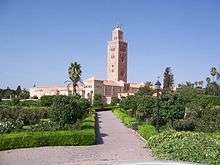




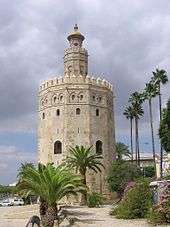

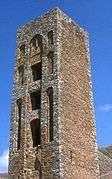
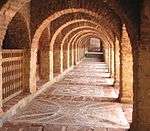
.jpg)



.jpg)
